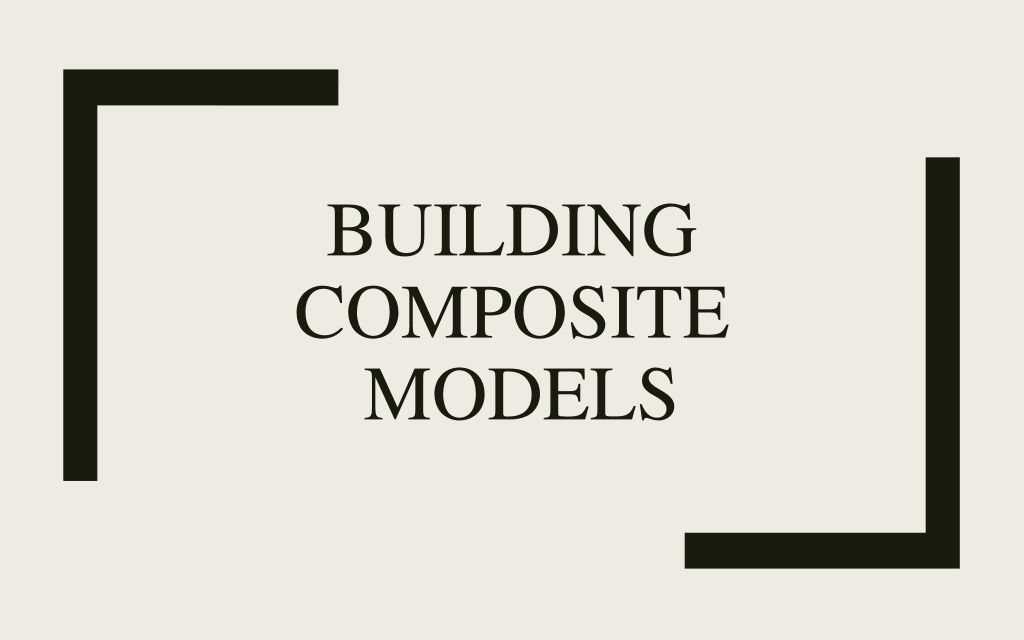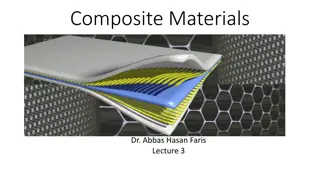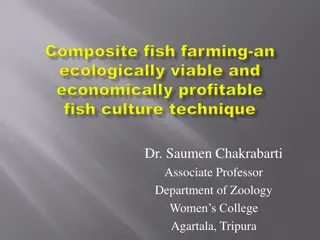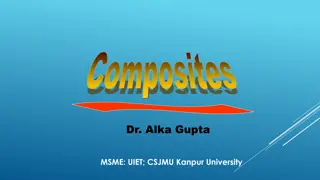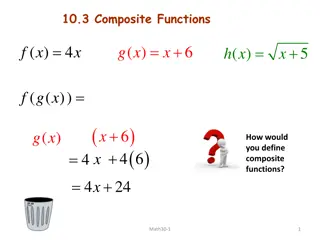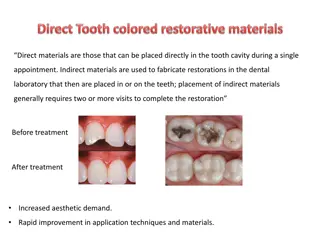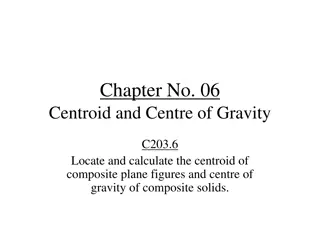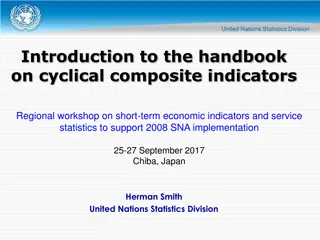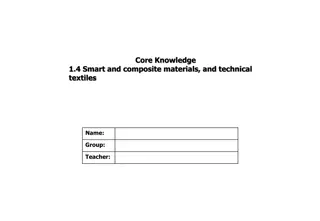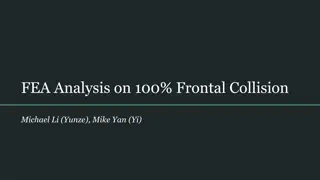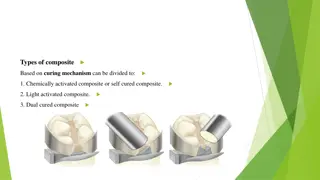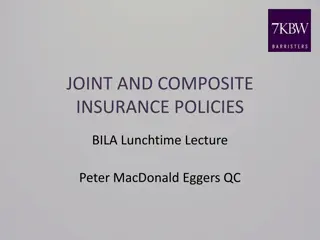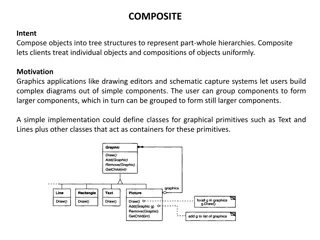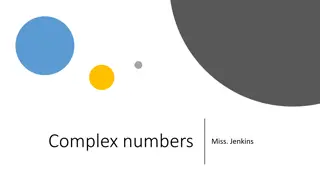Understanding Composite Models in Building Complex Systems
Composite models are essential in representing complex entities by combining different types of models, such as resource allocation, transport, and assembly models. Gluing these models together allows for a comprehensive representation of systems like the milk industry, where raw materials are transformed through various processes. Integrating models involves making fixed assumptions variable based on choices, leading to a more dynamic and accurate representation of interconnected processes.
Download Presentation

Please find below an Image/Link to download the presentation.
The content on the website is provided AS IS for your information and personal use only. It may not be sold, licensed, or shared on other websites without obtaining consent from the author. Download presentation by click this link. If you encounter any issues during the download, it is possible that the publisher has removed the file from their server.
E N D
Presentation Transcript
BUILDING COMPOSITE MODELS
Motivation The models we have looked at so far are often used as building blocks in making more complex models It is not unusual to see a model that has multiple locations and is a composite of say resource allocation models to make goods, transport models to move them and then something like a feed or assembly model where we use the goods as an input to make other products and finally a final good transport. This basically means we may need to glue together multiple types of model types to adequately represent the entity we are trying to model
Motivation (continued) Consider an example from the US milk industry. We might have a representation of dairy farms that produce raw milk in the form of a resource allocation model movement of raw milk to several processing locations via a transport model Processing of milk into fluid and cream plus ice cream, butter, yogurt etc in the form of both disassembly and assembly models Movement of final products to consumption locations using multiple transportation models This basically means we need to glue these three model types to represent either the industry as a whole or a vertically integrated firm in that industry
Basics of Model Gluing When gluing models we typically have to take things that were assumed to be fixed in availability like available supply or reflective of a single possible decision (like an items disposed of in one and only way - no choice) and Make them a consequence of choices involving variables Suppose we consider this in the case of integrating a resource allocation production model and a transport model
Basics of Model Gluing Let us prepare the transportation model. for integration with another model The basic transport model is ? ????,?????,? ???????? ? ?.?. ????,? ???? for all ? ????,? ???? for all ? ? ????,? 0 for all ? and ? ????,?is our transport variable telling how much is moved from each supply location (s) to each demand location (d) The first constraint limits outgoing shipments to available exogenous supply by supply location (s) The second insures incoming shipments are at least equal to exogenous demand by demand location (d)
Basics of Model Gluing First we will change the model to a maximization model with less than or equal to constraints. The resultant model is ? ????,? ????,? ???????? ? ?.?. ????,? ???? for all ? ????,? < ???? for all ? ? ????,? 0 for all ? and ? Next instead of supply being exogenous lets make it an endogenous variable. We also move the supply variable to the left hand side. The resultant model is ? ????,? ????,? ???????? ? ?.?. ????,? ???? 0 for all ? ????,? ???? for all ? ? ????,? , ???? 0 for all ? and ?
Basics of Model Gluing And going one step further instead of demand being exogenous lets also make it an endogenous variable. We also move the demand variable to the left hand side and add a sale price. The resultant model is ???? ???? ? ????,? ????,? ???????? ? ?.?. ????,? ???? 0 for all ? ???? ????,? 0 for all ? ? ???? , ????,? , ???? 0 for all ? and ? Now we have a model ready for gluing If this was to be our final model we would likely add some cost for supply and perhaps some constraints on supply and demand. We do not do that as we will gain those terms on the supply side when gluing
Basics of Model Gluing Now lets set up a joint products model so it is ready for gluing Suppose we have a model that purchases inputs (inp) from the market and employs a number of processes (prc) to produce a single good and that good sells at a predetermined price. Our basic model is Max ??? ???? ??? ?????? ?????? ?????????? ?????? S.t. 0 ?????? for all res ???? ??c ?l???? ?????? ??? ?s????,??? ?????? ?????? 0 for all inp ??c ????,??? ?????? ???? , Here we do not have alternatives for selling our good this we will alter as when we add transport we do not know exactly where to send the good so will thus need alternative variables We will also need to add a balance between supply and demand ?????? 0 for all prc,pos, inp ??????,
Basics of Model Gluing Now we add a dimension to the SALE , PRD and BUY variables that tells the location of activity by supply region (s) and the associated data for prices, cost, resource usage, resource endowment and yield ????? ????? ???,? ??????,? ??????,? ???,????????,? ??????,? Max S.t. ??????,? for all res and s ??? ??????,???,? ??????,? ????? ??? 0for all s ??? ???,? ??????,? for all inp and s ??????,? 0 ??c ????,??? ??????,s ?????, ??????,?, Here ?????tells how much is how much is sold at each production location (s), PRDprc,s tells the amount of each process (prc) employed at each location s and the second constraint balances ????? at each production location so it is less then or equal to production at that location and that is the amount produced by each process summed over all processes. The 3trdconstraint on inp requires the input consumed at production location s summed over all processes be less than the purchased inputs at that location (??????,?). Note all of the constraints and variablesnow have an added dimension for the production location ??????,? 0 for all s and prc
Basics of Model Gluing Now we have the 2 models ???????? ???? ???? ?.?. ? ????,? ????,? ? ????,? ???? 0 for all ? ???? ????,? 0 for all ? ? ???? , ????,? , ???? 0 for all ? and ? ????? ????? ???,? S.t. ??? ??????,???,? ??????,? ????? ??? ??c ????,??? ??????,s ?????, ??????,?, ??????,? ??????,? ???,????????,? ??????,? Max ??????,? for all res and s 0for all s ??? ???,? ??????,? for all inp and s ??????,? 0 ??????,? 0 for all s and prc Note here that the SALE variable in the transport model will now come from the joint product model and will be equivalent to the SALE variable in the joint products model. So we glue there and remove the price term allowing it to appear against the dem variable in the transport model
Basics of Model Gluing Now we glue models resulting in the following ??? ??? ???? ???,? ????,? ??????,? ??????,? ???????,? ??????,? ? ? ? ???,? ???,? ?.?. ????,? ???? 0 ? ???? ????,? 0 ? + ???? ????? 0 ????? ??? ??? ???,? ??????,? 0 ??????,? ??? ??????,???,? ??????,? ??c ????,??? ??????,s ??????,? 0 ???? ?????, ??????,?, ???? ????? ??????,? 0 Note here that the SUP variable is balanced with the SALE variable from the joint product model.
Basics of Model Gluing Note we can eliminate the sale and sup variables yielding ??? ??? ???? ???,? ????,? ??????,? ??????,? ???????,? ??????,? ? ? ? ???,? ???,? ?.?. ????,? ??? ???,? ??????,? 0 ? ??? ???? ????,? 0 ? ??????,? ??? ??????,???,? ??????,? ??c ????,??? ??????,s ??????,? 0 ???? , ????,? ??????,?, ??????,? 0 Our glued model
Toward more Gluing The possibilities for model gluing are large. In our example we could do things like the following Treat multiple products here we would add a product dimension to the basic production and movement variable along with the supply demand balance between outgoing shipments and total production Possibly add a disassemble component that cut animals into products replacing the dem variable. Further, the meat product could be reassembled into packs or sausage or bologna. Then we would glue an assembly model in and possible outgoing products via another transport structure
Gluing Tableau Models Suppose John has two dairy farms (Farm A and B) producing raw milk. Two milk processing companies (M1 and M2) would like to purchase milk from John. The milk processing companies require John to ship the raw milk to their facilities at his cost. John has two possible feeding options, just feed standard feed mix or feed 90% standard feed mix and 10% soybean meal. If John feeds the cow more soybean meals, it will yield more milk, but also consumes more labor. Prices of standard feed mix and soybean mills are $100 and $300 per US ton. The processing companies will purchase milk @ $3.5/gallon. M1 will purchase 1000 gallons and M2 will buy 1200 gallons More information is given in the tables.
Gluing Tableau Models Table 2: Resource Availability of Farms Table 1: Cost and yield of feeding procedure for Farm A and Farm B Farm A Farm A Farm B Farm B P1 P1 P2 P2 Cow (head) 100 200 Yield (gallon per cow per day) 6 7 Labor (Hour) 35 80 Standard Feed Mix (lb) 100 90 Soybean Meal (lb) 10 Table 3: Transportation cost ($/gallon) Labor (hour) 0.3 0.4 M1 M1 M2 M2 Processing cost ($) 4 5 FarmA 0.3 0.6 FarmB 0.2 0.5
Gluing Tableau Models We first build the joint model of Farm A, in which we allow purchasing inputs, processing to output and selling outputs. Soybean Meal Sales P1 P2 FeedMix level obj Milk Balance Feed mix balance soybean meal balance labor cow non-negative MAX 3.5 -4 -6 -5 -7 -0.05 -0.15 1 <= 0 100 90 -1 <= 0 10 0.4 -1 <= <= <= >= 0 0.3 35 100 1 1 1, 1, 1, 1, 1, 0
Gluing Tableau Models Now, we add a dimension to the SALES and PROD variables that tells the location of activity by supply region (s) and the associated data for prices, cost, resource usage, resource endowment and yield In the tableau we prepare one more tableau for Farm B and then glue them diagonally. Soybean Meal Sales P1 P2 FeedMix level obj Milk Balance Feed mix balance soybean meal balance labor cow non-negative 3.5 -4 -6 -5 -7 -0.05 -0.15 MAX <= 1 0 100 90 -1 <= 0 10 0.4 -1 <= <= <= >= 0 0.3 80 80 1 1 200 200 1, 1, 1, 1, 1, 0
Feed Mix FarmA Soybean Meal FarmA Feed Mix FarmB Soybean Meal FarmB Sales FarmA P1 P2 Sales FarmB P1 P2 FarmA FarmA FarmB FarmB level 3.5 -4 -5 -0.05 -0.15 3.5 -4 -5 -0.05 -0.15 Max obj 1 -6 -7 <= 0 Milk Balance FarmA 100 90 -1 <= 0 Feed mix balance FarmA 10 -1 <= 0 SoyMeal balance FarmA 0.3 0.4 <= 35 labor FarmA 1 1 <= 100 cow FarmA 1 -6 -7 <= 0 Milk Balance FarmB 100 90 -1 <= 0 Feed mix balance FarmB 10 -1 <= 0 soy meal balance FarmB 0.3 0.4 <= 80 labor FarmB 1 1 <= 200 cow FarmB 1, 1, 1, 1, 1, 1, 1, 1, 1, 1, >= 0 non-negative
Gluing Tableau Models Now we set up the transportation model As we don t know the supply availability of Farm A and B, we set the RHS parameter as a and b A/M1 A/M2 B/M1 B/M2 0.3 0.6 1 1 obj Farm A supply balance farm B supply balance M1 demand balance M2 Demand balance 0.2 0.5MIN <= 1<= <= -1<= a b 1 -1 -1 -1000 -1200 -1
Gluing Tableau Models Now we will change the model to a maximization model and include a sale price. A/M1 A/M2 B/M1 B/M2 3.2 2.9 1 1 obj Farm A supply balance farm B supply balance M1 demand balance M2 Demand balance 3MAX MAX <= 1<= >= 1>= 3.3 a b 1 1 1 1000 1200 1
Gluing Tableau Models Now we will change supply from being exogenously fixed to being an endogenous variable A/M1 A/M2 B/M1 B/M2 Supply A Supply B obj Farm A supply balance farm B supply balance M1 demand balance M2 Demand balance 3.2 2.9 3.3 3 Max 1 1 -1 <= 0 0 1 1 1 -1<= >= >= 1 1000 1200 1 1
Gluing Tableau Models FeedM ix FarmA Note here that the Supply variables in the transport model are equivalent to the SALEs Variables in the Joint products model. So we glue there and remove the price term allowing it to appear against the MVE variable in the transport model Soybean Meal FarmA Feed Mix FarmB Soybean Meal FarmB Sales Sales FarmA FarmA P1 FarmA P2 FarmA Sales Sales FarmB FarmB P1 FarmB P2 FarmB level obj Milk Balance FarmA Feed mix balance FarmA Soybean Meal balance FarmA 3.5 -4 -5 -0.05 -0.15 3.5 -4 -5 -0.05 -0.15 Max < = < = < = < = < = < = < = < = < = < = > = 1 -6 -7 0 100 90 -1 0 10 -1 0 labor FarmA 0.3 0.4 35 cow FarmA Milk Balance FarmB Feed mix balance FarmB soybean meal balance FarmB 1 1 100 1 -6 -7 0 100 90 -1 0 10 -1 0 A/M1 A/M2 B/M1 B/M2 Supply A Supply A Supply B Supply B 0.4 obj 80 3.2 2.9 3.3 3 Max labor FarmB 0.3 Farm A supply balance farm B supply balance M1 demand balance M2 Demand balance cow FarmB 1 1 200 1 1 -1 <= 0 non-negative 1, 1, 1, 1, 1, 1, 1, 1, 1, 1, 0 1 1 -1<= 0 1 1 >= 1000 1 1 >= 1200
Feed Mix FarmA -0.05 Soybea nMeal FarmA -0.15 Feed Mix FarmB -0.05 Soybean Meal FarmB AM1 -0.15 Sales FarmA P2 FarmA Sales FarmB P1 FarmB P2 FarmB Supply A Supply B mA AM2 BM1 BM2 3.5 obj Milk Balance FarmA Feed mix balance FarmA soybean meal balance FarmA labor FarmA cow FarmA Milk Balance FarmB Feed mix balance FarmB soybean meal balance FarmB labor FarmB cow FarmB Farm A supply balance farm B supply balance M1 demand balance M2 Demand balance Farm A Supply demand balance -4 -6 -5 -7 3.5 -4 -5 3.2 2.9 3.3 3 MAX <= 1 0 100 90 -1 <= 0 10 0.4 -1 <= <= <= <= 0 0.3 35 1 1 100 1 -6 -7 0 100 90 -1 <= 0 10 0.4 -1 <= <= <= 0 0.3 80 1 1 200 1 1 -1 <= 0 1 1 -1<= <= <= <= 0 -1 -1 -1000 -1200 -1 -1 -1 1 0 -1 Farm B supply demand balance non-negative 1<= >= 0 0 1, 1, 1, 1, 1, 1, 1, 1, 1, 1, 1, 1, 1, 1, 1, 1, Note we have linked milk transport to milk production
We can simplify the model to be this format Feed Mix FarmA -0.05 Soybea n Meal FarmA -0.15 Feed Mix FarmB -0.05 Soybea n Meal FarmB AM1 -0.15 Sales FarmA P1 FarmA P2 FarmA Sales FarmB P1 FarmB P2 FarmB AM2 BM1 BM2 obj Milk Balance FarmA Feed mix balance FarmA soybean meal balance FarmA labor FarmA cow FarmA Milk Balance FarmB Feed mix balance FarmB soybean meal balance FarmB labor FarmB cow FarmB Farm A supply balance farm B supply balance M1 demand balance M2 Demand balance non-negative -4 -6 -5 -7 -4 -5 3.2 2.9 3.3 3 1 <= 0 100 90 -1 <= 0 10 0.4 -1 <= <= <= <= 0 0.3 35 1 1 100 1 -6 -7 0 100 90 -1 <= 0 10 0.4 -1 <= <= <= 0 0.3 80 1 1 200 -1 1 1 <= 0 0 -1 1 1 1<= >= 1>= >= 1 1000 1200 1 1, 1, 1, 1, 1, 1, 1, 1, 1, 1, 1, 1, 1, 1, 0
Toward more GluingTableau As the example in the mathematical notation part If the farms have multiple products We built the joint model tableau with multiple output We then built multiple transportation models to ship products Gluing the joint models with transportation models by adding supply demand balance between the SALES variable in joint models and SUPPLY variables in transportation models
Toward more Gluing tableau Possibly disassemble an input like milk into component parts like skim milk and cream, then ship to customers Setup disassembly model Tableau to disassemble milk to skim milk and cream Multiple disassembly models are need if you have more than one disassembling facilities Build more transportation model, not only for different locations, but also for different products Gluing joint model with disassembly model(s). The SALES variables in joint models are equivalent to INPUT variables in disassembly models. Gluing the big model with transportation models. The OUTPUT variables in disassembly model are equivalent to Supply variable in Transportation model
Toward more Gluing tableau Further, the skim milk, cream and butter disassembled from the raw milk can be processed to diary products, e.g ice cream, yogurt, sour cream, and different types of cheeses. Build assembly model tableau Then we can glue one assembly model after gluing disassembly model and change the transportation model to ship the final products. The output variables in disassembly model will be the input variables in assembly model and the output variables in assembly model will replace the supply availability parameters in transportation model
